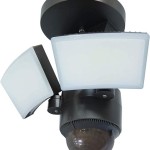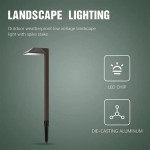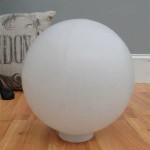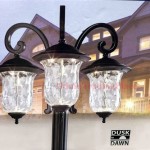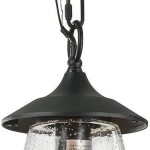Outdoor Light Pole Sensors: Illuminating Efficiency and Security
Outdoor light pole sensors have become an indispensable part of modern urban and rural environments. These intelligent devices seamlessly integrate with lighting infrastructure, offering a range of benefits that enhance safety, energy efficiency, and overall convenience. From motion activation to environmental monitoring, light pole sensors play a crucial role in optimizing lighting systems and creating smarter, more responsive communities.
Enhanced Safety and Security
The primary function of outdoor light pole sensors is to enhance safety and security by providing illumination only when and where it is needed. Motion detection sensors, for instance, trigger lights to activate when they detect movement, illuminating areas only when someone is present. This eliminates the need for constant illumination, conserving energy and reducing light pollution. Moreover, the sudden illumination can act as a deterrent to potential crime, providing a sense of security for pedestrians and residents.
Beyond motion detection, light pole sensors can also incorporate other security features. Some sensors are equipped with cameras that capture images or video footage upon activation. These capabilities enable real-time monitoring of suspicious activity, enhancing situational awareness and empowering security personnel to respond swiftly to incidents.
Energy Efficiency and Cost Savings
Outdoor light pole sensors significantly contribute to energy efficiency and cost savings. By activating lights only when necessary, they reduce energy consumption compared to traditional lighting systems that operate continuously. This translates into substantial reductions in electricity bills and environmental impact. The savings can be further amplified by integrating sensors with smart lighting control systems that adjust brightness levels based on ambient light conditions, maximizing energy efficiency.
Furthermore, light pole sensors enhance the longevity of lighting fixtures. By reducing the amount of time lights are operational, sensors minimize wear and tear on bulbs and components, extending their lifespan and reducing maintenance costs. This creates a more sustainable and cost-effective lighting infrastructure that requires fewer replacements and repairs.
Smart City Applications and Data Collection
Outdoor light pole sensors extend beyond illumination, playing a vital role in the development of smart cities. They serve as data collection points for a variety of environmental and traffic monitoring applications. Sensors can collect data on factors such as air quality, noise levels, temperature, and traffic flow. This information can be used to optimize city services, improve traffic management, and make data-driven decisions for urban planning.
The data collected from light pole sensors can be integrated into intelligent city management systems. These systems use real-time data to optimize lighting schedules, adjust traffic signals, and provide citizens with information on environmental conditions. By leveraging the capabilities of light pole sensors, cities can become more responsive, efficient, and sustainable.
Types of Outdoor Light Pole Sensors
Outdoor light pole sensors come in various types, each offering unique capabilities and applications. The most common types include:
-
Motion Sensors:
These sensors detect movement using infrared or microwave technology. They activate lights when they detect motion, providing illumination only when needed. -
Light Sensors:
These sensors measure ambient light levels and adjust light intensity accordingly. They ensure optimal illumination while minimizing energy consumption. -
Temperature Sensors:
These sensors monitor ambient temperature and can be used to activate heating or cooling systems within outdoor spaces. -
Acoustic Sensors:
These sensors detect sound levels and can be used for applications such as noise pollution monitoring or security alarms.
The choice of sensor type depends on the specific application and desired functionality. For example, motion sensors are ideal for security applications, while light sensors are suited for energy-efficient lighting control.
Outdoor light pole sensors are not only enhancing the functionality and efficiency of lighting systems but also contributing to the creation of smarter, more sustainable urban environments. As technology continues to evolve, the capabilities and applications of light pole sensors are expected to expand, leading to further innovation and societal benefits.

Led Solar Motion Sensor Street Post Light For Outdoor Park Garden Patio China Made In Com

Best Customization Of 8m Street Pole 60w Led Road Light Motion Sensor Lithium Battery And Solar Panel Integrated Waterproof Outdoor China

Ip65 40w Ufo Led Lamp Post Waterproof Outdoor All In One Solar Street Sensor Light China Garden Made Com

Outdoor Bright 12w 24w Led Solar Pole Wall Street Light Sensor Lamp

Solus 6 Ft Broe Outdoor Lamp Post With Dusk To Dawn Photo Sensor Fits 3 In Top Fixtures Sm6 320ncastv Bz The Home Depot

Dusk To Dawn Sensor Outdoor Lamp Post Light 3 Head Classic Black Pole With Clear Glass Panels Led Bulbs Included Max 100w Waterproof Outside Street For Backyard Garden Driveway Com

Aluminium Pole Garden Outdoor Light With Motion Sensor Post Top Lighting China Led Lights Made In Com

Solus 6 Ft Broe Outdoor Lamp Post With Convenience And Dusk To Dawn Photo Sensor Fits 3 In Top Fixtures Sm6 C320ncastv Bz The Home Depot

Solar Light Outdoor Waterproof Monitor Sensor Ufo Type Led Furniture Home Living Lighting Fans On Carou

Aluminium Pole Garden Outdoor Light With Motion Sensor Post Top Lighting China Led Lights Made In Com
Related Posts
